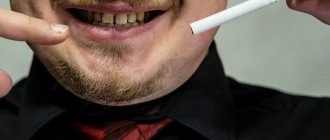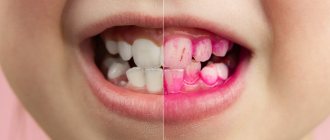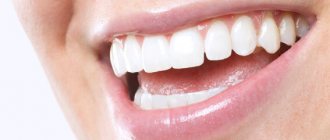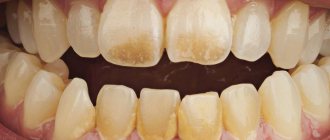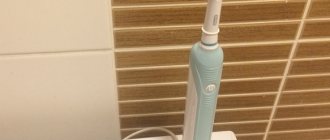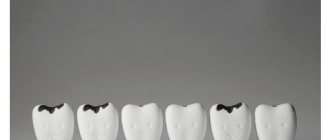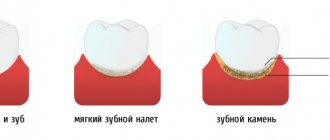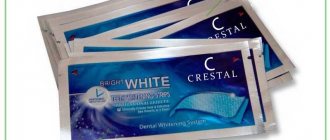01.12.2019
In order to figure out how to remove plaque on teeth after smoking, you need to understand the reasons for its formation. Smoking has a direct negative effect on the entire body and, in particular, contributes to the darkening of tooth enamel.
The best solution to the problem is to completely abandon this unhealthy habit. This will protect your health and preserve the natural whiteness of your teeth. If you really can’t quit smoking, then you can reduce the consequences for tooth enamel by regularly using special hygiene methods.
The effect of smoking on teeth color
Important! Cigarette smoke contains a huge list of substances and elements, including nicotine and various tars. With regular smoking, microparticles settle on the teeth and a specific yellowish plaque forms.
At the first stage, the problem is purely aesthetic in nature, but if it is not addressed, plaque leads to the formation of tartar, and also causes inflammation of the gums and contributes to the development of caries. The plaque caused by smoking initially has a yellow tint, but over time becomes darker to grayish-brown and black.
Gum inflammation caused by this harmful habit can become serious, accompanied by bleeding, gingivitis, periodontal disease and chronic bleeding gums. Smokers are also at risk of developing tooth decay. Almost all lovers of this habit have teeth in their mouths that require treatment. Their caries develops quickly, endlessly transmitted from tooth to tooth.
In addition, there are statistics according to which four out of ten smokers completely lose their teeth by age 65. Among non-smokers this figure is two times lower.
How does tobacco affect the oral mucosa?
The teeth of a healthy person and a smoker also differ in that the latter are much more likely to have problems with the oral mucosa. The mildest of these are dry mouth (xerostomia) and an unpleasant odor, which increases due to the breakdown of components of tobacco products. Due to inhalation of hot smoke, tobacco stomatitis and leukoplakia often occur - compacted spots on the mucous membrane, framed by a white coating. In heavy smokers, doctors often diagnose leukokeratosis, which manifests itself in the form of seals (usually on the lower lip). This disease may well be a precursor to cancer, since the tumor often becomes malignant over time. Smoking often becomes one of the causes of gingivitis and periodontitis, and also significantly complicates the treatment of any inflammatory processes in the periodontium.
Features of plaque from tobacco smoke
Plaque that appears on teeth can be of different colors:
- yellow and brownish;
- white;
- black;
- green.
Important! The most harmless is a white coating. It forms on the teeth quite quickly, for example, overnight or during the day. The reason for its appearance is the food consumed, as well as bacteria and microbes that multiply on the surface of the teeth.
Such plaque, if removed in a timely manner, does not pose any particular danger. It can be removed during regular brushing with a toothbrush. Green plaque is rare and mainly appears due to damage to the pellicle (the protective layer of the tooth located on the surface of the enamel). Also, this shade of plaque can be caused by a fungal infection of the oral cavity.
Yellow and brown plaque appears due to tooth pigmentation caused by smoking, as well as from excessive consumption of strong tea and coffee. This type of plaque is difficult to remove on your own. The easiest way in such a situation is to have it professionally cleaned by a dentist. Black plaque is an advanced form of pigmentation, which initially had a yellow or brown tint.
Signs of a smoker's plaque
Signs of this unpleasant phenomenon are visible to the naked eye. If desired, every smoker can detect them. To do this, just carefully examine your mouth and teeth in front of the mirror. In this case, the following symptoms of the problem may be observed.
- Visible change in enamel color towards darkening.
- The presence of yellow, brown or black plaque on the neck of the tooth (at the base) or on the inside of the dentition.
- Uncharacteristic color of gums, which look a little “overdried.”
After detecting these signs, all that remains is to exhale sharply into your palm to feel the bad breath - the eternal companion of heavy smokers.
The presence of one or more signs of cigarette plaque is a serious reason to contact specialized specialists - dentists.
Ways to get rid of plaque
Some smokers believe that it is impossible to get rid of the yellow tint of teeth. This is wrong. It is quite possible to whiten yellowed enamel, and you can even try to do it at home. However, if the case is advanced, and the plaque has turned from yellowish to brown or even black, then folk remedies are likely to be ineffective. A dentist will help you thoroughly clean your teeth from old pigmentation.
Home whitening methods
When choosing methods for getting rid of plaque, you need to understand that home procedures will take much more time than professional cleaning at the dentist.
To remove plaque at home, you can use the following methods:
- Using baking soda. The abrasive properties of this substance allow you to effectively remove plaque and polish tooth enamel. To achieve results, you can use baking soda in its pure form or add it to your usual toothpaste. You can use this method no more than twice a week.
- Lemon peel. Rubbing the surface of the teeth with the crust of this fruit helps lighten the enamel.
- Cleaning with activated carbon. Crushed charcoal is applied to the brush and the teeth are cleaned with gentle movements. The method is highly effective, however, the efforts made should be controlled to avoid damage to the enamel.
- Using tea tree oil. This product is distinguished by its safety and has an additional antibacterial effect. After cleansing your teeth with regular toothpaste, apply a few drops of oil to your brush and gently brush your teeth again. Then rinse your mouth with water and a few drops of lemon. After the procedure, you may feel a slight numbness.
- Hydrogen peroxide. A few drops of peroxide solution are applied to a cotton swab and wiped over the teeth. After this, you need to perform hygiene with toothpaste and then rinse your mouth thoroughly. Peroxide has a pronounced effect, but has an adverse effect on the enamel.
- Factory products. Effective is the use of various whitening gels applied to the teeth using a special tray. Lightening agents in the form of strips have a similar effect. When using these devices, you must be careful and strictly follow the instructions in the instructions.
In order to avoid plaque caused by a bad habit, you need to brush your teeth after every cigarette you smoke. Unfortunately, this opportunity does not always exist. Regular use of home whitening methods will help get rid of fresh plaque and prevent it from acquiring a dark shade.
Attention! In addition to the above methods, it would be useful to include solid vegetables and some types of fruits in your diet, which help clean and brighten your teeth. These include: strawberries, apples, lemons, celery and carrots.
Features of whitening with soda
When wondering how to remove plaque on teeth after smoking, many people opt for baking soda.
The method is really effective, although there are contraindications, such as:
- tendency to bleeding gums;
- increased sensitivity of enamel;
- enamel pathologies (fluorosis, hypoplasia);
- carious infections.
If the listed contraindications are absent, you can try this type of whitening. Procedure steps:
- Prepare soda in the form of a dry powder or a paste-like mixture with water. You will also need a toothbrush.
- Baking soda must be applied to the toothbrush (if using dry powder, the brush must be moistened with water).
- Brush your teeth, being careful and trying not to get it on the oral mucosa.
- Rinse your teeth thoroughly.
This method should not be used more than twice a week. Baking soda can be used not in its pure form, but added to regular toothpaste.
Professional teeth cleaning after smoking
Advanced forms of plaque on teeth are best left to the dentist. A professional approach to lightening enamel after smoking includes two types of procedures:
- Professional hygiene. The procedure is carried out using soft abrasive cleaning and ultrasonic methods. During the manipulation process, teeth are even removed from old plaque and tartar.
- Enamel whitening. This method is used when the natural color of the teeth is not satisfactory, and the patient wants to have a perfectly snow-white smile.
Sometimes combined methods are used, combining them with subsequent remineralization of tooth enamel.
Methods of teeth whitening in dentistry
There are several types of professional dental teeth whitening. Your doctor can advise you on the most effective method.
Mechanical bleaching
This method is the most accessible and simple. To clean the enamel, dental attachments are used, with the help of which plaque and stones are effectively removed. After the procedure, the doctor applies a gel to the teeth that protects the enamel.
Chemical procedure
The method is gentle. After it, the teeth become lighter by just a few shades. The gums are covered with a latex protective sheet, after which a concentrated whitening solution is applied to the teeth. The procedure will not apply if the patient has veneers, crowns or fillings.
Photobleaching
The procedure allows you to whiten your teeth by 7-8 tones. The doctor applies the whitening gel and shines a lamp on it. The procedure lasts from 15 to 45 minutes. After the procedure, the doctor applies a product with a high fluoride content to reduce tooth sensitivity.
Prevention
It is always easier to prevent pathology than to treat it. In order to avoid the appearance of plaque, it is best to get rid of the bad habit of smoking. If this cannot be done, then you need to at least minimize the number of cigarettes you smoke. Additional preventive measures are:
- thorough dental hygiene at least twice a day using a toothbrush, floss and mouthwash;
- timely replacement of the toothbrush;
- rinsing the mouth after every meal or smoking;
- control over the amount of coffee and strong tea consumed;
- alternating different types of toothpaste;
- regular oral hygiene at the dentist.
It is better to solve the problem at the stage while the above simple recommendations are effective. If you do not give up the bad habit, as well as neglect preventive measures, then plaque after smoking can lead to serious oral diseases.
Category Hygiene Published by Mister stomatolog
General recommendations
To keep your teeth white and healthy, you not only need to whiten periodically, but also follow these rules:
- brush your teeth at least 2 times a day, thoroughly cleaning all surfaces of the teeth and spending at least 5 minutes on the procedure;
- use medicated paste constantly and periodically alternating it with a special whitening paste - we brush our teeth with a regular paste for 3 months and with a special whitening paste for 1 month;
- limit the consumption of strong tea, coffee, carbonated drinks and other products that stain tooth enamel;
- reduce consumption of foods containing high concentrations of sugar;
- give up smoking - only by completely giving up smoking can you achieve whiter teeth, otherwise you will have to carry out whitening constantly, and the result will get worse every year.
Types of raid
Plaque formation is a normal process that occurs constantly. At the first stage, it even performs protective functions, protecting the enamel from external factors.
White plaque is a thin film that appears within a couple of hours after brushing your teeth. If we maintain hygiene and do not give up solid food - carrots, strong apples, crackers - part of the plaque is cleaned off. What remains is the one that got into the interdental spaces.
You can remove it with floss at home. If this is not done, it gradually hardens, mineralizes, turning into tartar. It is impossible to whiten teeth with such deposits at home. Requires professional cleaning. Smokers' teeth are particularly susceptible to becoming overgrown with such fossils.
Signs and consequences of a raid
Plaque does not always have a white tint. Color varies depending on circumstances. Let's see what plaque happens and why it occurs:
- Yellow. The color is due to frequent consumption of sweets. Microparticles of food penetrate deep into the white plaque and change its hue. Those who love buns and sweets often experience such a raid. Cigarettes have the same effect: the smoker’s teeth are almost always yellow. Lovers of strong coffee and steeply brewed black tea also often suffer from such a raid.
- Grey. The reason is enamel hypoplasia. The disease needs to be treated by a dentist. It is easy to deal with it using modern methods.
- Brown. This color is worn by experienced smokers. First, a yellow film appears on the crowns, then it darkens. The result: a permanent, dark-colored coating that can only be removed with hygienic cleaning and bleaching. Another reason for brown plaque is metabolic diseases and gastrointestinal tract diseases. Sometimes the crowns that cover dilapidated teeth are made with an admixture of copper - then the plaque takes on a brownish tint.
- Green. This color is possible for children. Sometimes adults also suffer due to the destruction of enamel.
- Black. With such a plaque, doctors recommend checking the condition of the biliary tract, and also eliminating the presence of parasites in the body. Plaque is removed in the dentist's office.
Whatever the color of the plaque, if it is not removed, it will mineralize. After 10 days it is already hard tartar. Whitening pastes and other home remedies will not cope with it.
There are 2 types of stone:
- supragingival (in open areas of teeth);
- subgingival (in the pocket, on the neck of the tooth).
Fresh supragingival plaque can be removed with a toothbrush, but subgingival plaque can only be cleaned using professional treatment methods.
List of prohibited products
In the first two weeks, you need to treat your teeth especially carefully. Hot and cold food is prohibited; everything should be moderately warm. There is no need to expose the enamel to even mild acid, so you will have to exclude fermented milk products.
With a white diet, you eat everything that is light in color. Animal products include:
- white meat and fish,
- egg white,
- soft cheese (mild and without spices),
- fresh milk,
- butter.
The following herbal products are acceptable:
- rice,
- pearl barley,
- cereals,
- white beans,
- potato,
- pasta,
- flour products (only without sugar and coloring ingredients),
- light mushrooms (champignons or porcini),
- light vegetable oil,
- white sweet pepper,
- peeled cucumbers,
- bananas,
- white and clear drinks (non-alcoholic).
The remaining vegetables and fruits are divided into two groups: unacceptable and conditionally acceptable. For example, beets or carrots are prohibited in any form. Conditionally acceptable include those for which heat treatment is sufficient to destroy the acid and weak pigment. For example, boiled cabbage or sour baked apples without peel.
Do not use:
- dairy products;
- egg yolk;
- red fish;
- red meat;
- sausage and ham (contains dyes);
- light fruits (if they are sour and have peel);
- colored fruits and vegetables;
- greenery;
- unpeeled cucumbers;
- sweets;
- spices, sauces, vinegar;
- colored drinks (including coffee, black and even green tea);
- alcohol.
- In the first four days after bleaching, you must strictly follow the rules. From the 5th day you can allow yourself relaxations, but small ones. For example, drink green tea through a straw or fermented baked milk, then immediately brush your teeth or rinse your mouth.
It is advisable to adhere to a white diet for a month, the minimum required period is 14 days. At this time, it is not yet recommended to paint your lips, since accidentally getting gloss or lipstick on the enamel is equivalent to using a coloring product.
The danger of untimely treatment and plaque removal
The appearance of cigarette residue cannot be ignored! Especially if it is accompanied by gingivitis, bad breath and bleeding gums. Failure to promptly seek help and remove plaque will lead to the progression of gingivitis, which will cause periodontal disease - periodontitis. In turn, periodontitis is accompanied by mobility of the dentition, which can ultimately result in tooth loss.
We should not forget about such a dental problem as caries, the main reason for the development of which is dental plaque. The pathogenic microorganisms that “live” in it, day after day, destroy not only the enamel, but also the hard tissues of the tooth, which will ultimately lead to its loss.
Cost of services
If treatment is started on the day of treatment, consultation and treatment plan are free
| Teeth whitening ZOOM-3 lamp (up to 8 tones smile zone) | RUR 22,300 |
| Express whitening ZOOM without lamp (4 tones) | 8,000 rub. |
| Tooth polishing Detastrin | 150 rub. |
| Removal of dental plaque (1 tooth) | 120 rub. |
| Whitening Air Flow (1 tooth) | 150 rub. |
| Local fluoride enrichment (1 tooth) | 270 rub. |
| Home whitening kit | 8,600 rub. |
| Restoration of a damaged tooth | from 5,600 rub. |
| Composite veneer (front tooth restoration using Estelite material) | RUB 9,500 |
| Comprehensive teeth cleaning (Air Flow + Ultrasound) | 6,200 rub. |
Photos of plaque from smokers
If you are still tormented by doubts about quitting smoking or allowing yourself to calm your nerves in this way, take a look at the photo: here is an image of the teeth of a smoker.
Smoker's teeth
Impressive? Do you really want to have teeth of the same “pleasant” dark brown shade?
Plaque on the teeth of a cigarette lover

